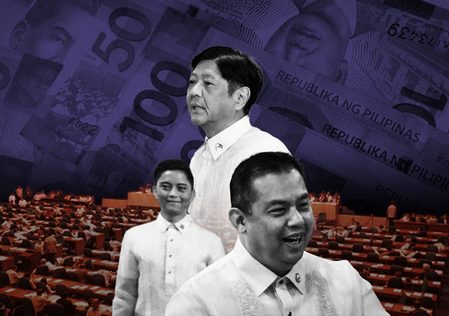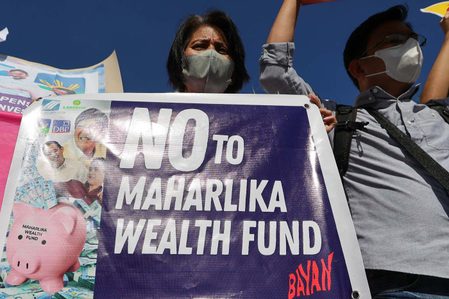SUMMARY
This is AI generated summarization, which may have errors. For context, always refer to the full article.

MANILA, Philippines – The Philippines may soon have its own sovereign wealth fund as the Marcos-backed Maharlika fund proposal makes its way through Congress. But what is a sovereign wealth fund exactly?
According to the bill’s proponents, a sovereign wealth fund (SWF) would help “contribute to nation-building.” The dream is for the SWF to finance dams, electric grids, and other big projects using money from government banks – and previously, even government pension funds.
“The President’s expressed aspiration is for the Fund to contribute to nation-building. The Fund will pool resources towards that direction, since many of these projects are capital-intensive,” said House ways and means committee chairman Joey Salceda in a statement on December 1.
The government financial institutions (GFIs) would get to invest in projects they normally couldn’t finance on their own, they would earn higher returns, and the public would finally have much-needed infrastructure. For the government, it’s a win-win.
Experts, on the other hand, are not convinced.
But before that, let’s talk about what a sovereign wealth fund is.
How do good sovereign wealth funds work?
A sovereign wealth fund uses similar concepts as a mutual fund or unit investment trust fund (UITF), except at the state level. Like these other investment funds, it also gathers a big pool of capital from different investors.
The fund can then be used to collectively invest in big projects with high returns. This allows everyone in the SWF to benefit from high-capital investments that investors could not have afforded individually.
Sovereign wealth funds have several benefits according to the World Bank. For governments with extra money on hand, it can become a way to earn interest on what would otherwise become idle savings.
“In many countries – especially those with fiscal revenues that are large relative to their populations or economies – it makes sense to set aside a portion of oil or mineral wealth. A government can earn interest on these savings and use that interest to finance crucial social services and public investments,” the World Bank wrote in a 2021 working paper.
Norway and Singapore, both home to some of the most renowned SWFs, use profits from their massive funds to finance their budgets, with as much as 20% of their budgets coming from their respective sovereign wealth funds.
However, for many SWFs, profit isn’t everything. Many SWFs act similarly to development banks, pursuing both profitability and social returns. Using its big pool of funds, a SWF could act as an early investor in new sectors or in projects that don’t receive the necessary backing from the private sector.
“[Sovereign wealth funds] will sometimes act as ‘cornerstone investors,’ signaling to private sector investors that the government is committed to a given project or company, and as a catalyzer for investments in new industries or projects that may have a social benefit but that the private sector has chosen to avoid,” the World Bank wrote.
A good example is how Quebec’s sovereign wealth fund – Caisse de dépôt et placement – has invested in renewable energy start-ups and local businesses attempting to go global.
An SWF can also work as multiyear budgets earmarked for specific purposes, like infrastructure. Unlike traditional budgets that are set on an annual basis, a SWF can retain unspent funds at the end of the year. The best example of this is Timor-Leste’s Infrastructure Fund, which is funded by the country’s oil and gas revenues.
“Since its inception, the Infrastructure Fund has financed projects that have electrified 75 percent of Timor-Leste territory, rehabilitated ports, irrigated three regions, and paved many public roads,” the World Bank noted.
Timor-Leste’s Infrastructure Fund accomplished these while abiding by strong safeguards. The fund must submit 5-year budgets for the approval of parliament, and the spending of the budget must follow normal budgetary procedures.
“In terms of transparency, governance, and effectiveness, these funds are in many ways models to emulate,” the international lender added, also praising Timor-Leste’s Human Capacity Development Fund.
How can sovereign wealth funds go wrong?
But while there are certainly successful SWFs, the World Bank also noted instances where funds “have served as channels for corruption and patronage, wasting scarce resources and empowering certain groups of elites at the expense of others or the general population.”
This happens when a sovereign wealth fund lacks proper checks and balances. In such a case, SWFs can become “extrabudgetary slush funds” controlled by the executive branch and working outside proper legislative oversight.
For instance, Angola’s sovereign wealth fund, Fundo Soberano de Angola (FSDEA), supported good programs such as One Laptop Per Child and a multimillion-dollar development project for fiber plantations. However, FSDEA also became embroiled in scandal after the fund’s manager invested hundreds of millions of dollars into projects related to him and the fund’s chairman.
Another extreme example of a mismanaged SWF is the Libyan Investment Authority (LIA). The LIA once put in $1.2 billion in derivatives investments and had nearly everything wiped out, losing $1.18 billion out of the $1.2 billion.
Closer to home, we have the most infamous example of a mismanaged and corrupt sovereign wealth fund: the 1Malaysia Development Berhad (1MDB) fund. The Malaysian SWF was originally designed to attract foreign investment in the country through joint ventures.
Over more than a decade of corruption, ex-prime minister Najib Razak managed to exert his political influence on 1MDB even without being designated as the head of the fund. After siphoning away as much as $1 billion for himself, Najib is currently serving a 12-year prison sentence.
Would a sovereign wealth fund work in the Philippines?
Before we start our sovereign wealth fund, we must first answer the big question: where do we get the money from?
According to the World Bank, most sovereign wealth funds are financed using the excess funds of their governments, such as in the case of Norway, Qatar, and Saudi Arabia. This surplus often comes from natural resource extraction. Recognizing that the profits from oil will one day run dry, these countries have invested the money in long-term funds for sustainability.
A country doesn’t need to earn a surplus before it sets up a sovereign wealth fund though. Some countries with low or declining public debt levels have also set up their own funds, such as Botswana and Russia. But there are also some sovereign wealth funds that have been established despite their governments having no budget surplus and unfavorable debt levels.
“However, sovereign wealth funds are sometimes created prematurely where unsustainable debt levels mean that the earnings from foreign financial investments are lower than the interest rate being paid on public debt,” the World Bank wrote.
The Philippines has neither a budget surplus nor low public debt levels. Experts warn that this places us in a bad situation to start such a fund.
“Conceptually, a sovereign wealth fund is good for a country if it is in a position to have one already. Historically, SWF arise from the budget surplus of oil exporting countries. Unfortunately, the Philippines does not currently enjoy that surplus and has no excess funds to invest. In fact, it has to borrow to finance its developmental requirements,” Enrico Villanueva, a senior lecturer of economics at the University of the Philippines Los Baños, said in an email interview.
Villanueva also pointed to the country’s history of fund mismanagement: “Critical to its success are the people handling the fund. The Philippines has had a history of funds mismanagement and scandals: Coco Levy, PhilHealth scandal, and SSS fund being used for politically-tainted stock purchases. [S]o yes, the Malaysian fund scandal can happen here,” he said.
Senator Risa Hontiveros also pointed to the country’s debt levels and trade deficits as signs that the Philippines can’t afford to set up a sovereign wealth fund.
“Indonesia has those super profits from their coal and oil exports. We, on the other hand, have super trade deficits. So, considering today’s economic uncertainty, setting up the Maharlika Fund has neither rhyme nor rhythm. How can we set something aside for the rainy days, when our national budget itself is deficit-funded?” Hontiveros said in a press statement on December 6.
Nation-building without a sovereign wealth fund
But according to experts, a sovereign wealth fund isn’t the only way to finance big-ticket national development projects. In fact, it might not even be the best way.
Rather than setting up a sovereign wealth fund, it may be more efficient to allocate funds for infrastructure development straight from the national budget, according to Zy-za Suzara, executive director of Institute for Leadership, Empowerment, and Democracy.
“While the SWF is envisioned to generate investment returns in the long run, direct investments for infrastructure can be done through the general appropriations act,” Suzara said in a Twitter interview.
She also said that the government is already investing about P1 trillion a year in infrastructure even without a sovereign wealth fund, as reported in the Department of Budget and Management’s Budget of Expenditures and Sources of Financing.
“From 2020 to present, total infrastructure outlays amount to P3 trillion. P2 trillion of that went to the budgets of public works, transportation, and irrigation projects,” she said. “That amount is nowhere near the proposed seed capital for the Maharlika fund, especially with the proposed amendments last week.”
Lawmakers have recently slashed the Maharlika fund’s initial capital from P275 billion down to about P105 to P110 billion.
Villanueva also disagreed with the government’s reasoning that a SWF will allow more development projects that would otherwise be removed by Congress from the annual budget.
“People are generally supportive of development. If development projects of the executive branch do not gain Congressional support, it can be that there are valid issues with the project (destruction of the environment, displacement of people and their livelihood, etc),” he said.
“National development projects do not need a SWF to happen. We have had dams built without a SWF.” – Rappler.com
Add a comment
How does this make you feel?

![[ANALYSIS] Bakit problematic ang Maharlika fund? Narito ang 4 na dahilan](https://www.rappler.com/tachyon/2022/12/problematic-maharlika-fund-december-8-2022.jpg?fit=449%2C449)

![[EDITORIAL] Apat na taon na lang Ginoong Marcos, ‘di na puwede ang papetiks-petiks](https://www.rappler.com/tachyon/2024/07/animated-bongbong-marcos-2024-sona-day-carousel.jpg?resize=257%2C257&crop=280px%2C0px%2C720px%2C720px)
![[In This Economy] Delulunomics: Kailan magiging upper-middle income country ang Pilipinas?](https://www.rappler.com/tachyon/2024/07/in-this-economy-upper-middle-income-country.jpg?resize=257%2C257&crop=421px%2C0px%2C1080px%2C1080px)

![[EDITORIAL] Marcos Year 2: Hilong-talilong](https://www.rappler.com/tachyon/2024/07/animated-bongbong-marcos-2nd-sona-carousel.jpg?resize=257%2C257&crop=136px%2C0px%2C720px%2C720px)
![[Newspoint] A fighting presence](https://www.rappler.com/tachyon/2024/07/thought-leaders-a-fighting-presence.jpg?resize=257%2C257&crop=441px%2C0px%2C1080px%2C1080px)
There are no comments yet. Add your comment to start the conversation.